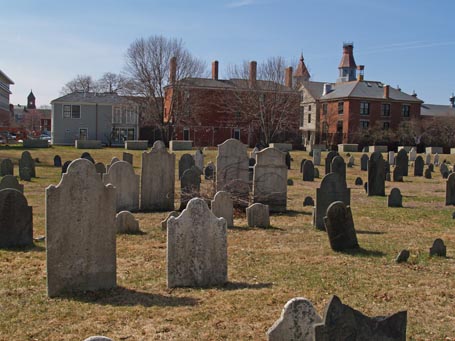 Old Salem Jail complex, now 50 St. Peter, seen from the cemeteryI arrived for the open house a little late. This wasn’t your typical open house; this was the big house, the Old Salem Jail. I found a line two- to three-people thick starting at the c. 1813 jail entrance, trailing past the c. 1813 jail-keeper’s house, and turning at the new carriage house which stands on the footprint of its barn predecessor.
Old Salem Jail complex, now 50 St. Peter, seen from the cemeteryI arrived for the open house a little late. This wasn’t your typical open house; this was the big house, the Old Salem Jail. I found a line two- to three-people thick starting at the c. 1813 jail entrance, trailing past the c. 1813 jail-keeper’s house, and turning at the new carriage house which stands on the footprint of its barn predecessor.
From the excited chatter in the line you might have thought we were queuing up to see a prestigious show. Instead, we were eagerly anticipating the transformation of the jail’s three-building complex into 23 rental units, a restaurant, and jail exhibit. I was among, what Merry Fox Realty estimates to have been, 3000 curious visitors. So what’s all the fuss about?
“I think any time you have a quality building that’s built from this early of an era, it’s exciting to those of us who are really interested in historic architecture,” explains architect Jim Alexander of Finegold Alexander + Associates Inc. who teamed up with developer New Boston Ventures LLC and Metric Construction to bring the complex, renamed 50 St. Peter, to reality.
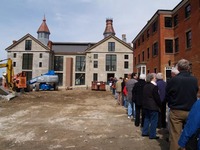 Open HouseSince it was vacated in 1991, the hulking granite and brick jail had been lurking behind a razor-wire fence and aggressive weeds on prime property. In 2005 New Boston Ventures LLC stepped in with a mixed-use proposal that included market-rate condominiums. When the economy stumbled in 2008/2009, so did the project. As a result, the developer switched gears and secured alternative financing via historic tax credits administered by the National Park Service in order to develop rentable apartments which will be eligible for condo conversion in five years. Now those apartments are scheduled for June 1 occupancy.
Open HouseSince it was vacated in 1991, the hulking granite and brick jail had been lurking behind a razor-wire fence and aggressive weeds on prime property. In 2005 New Boston Ventures LLC stepped in with a mixed-use proposal that included market-rate condominiums. When the economy stumbled in 2008/2009, so did the project. As a result, the developer switched gears and secured alternative financing via historic tax credits administered by the National Park Service in order to develop rentable apartments which will be eligible for condo conversion in five years. Now those apartments are scheduled for June 1 occupancy.
“What our goal was, and I’m hoping we accomplished, is to offer the highest level of finish ever offered in a rental development on the North Shore,” says David Goldman a principal at New Boston Ventures and its affiliate Old Salem Jail Ventures LLC.
The Bryant, McIntire, and Carriage House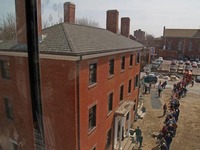 The McIntire from The BryantThe development’s $12 million renovation encompasses three components including the 30,896 gross sq. ft. jail whose original architect is unknown. The c. 1884 additions were designed by Gridley J. F. Bryant. Today, the jail building is named The Bryant after him. It contains a jail cell exhibit near the entrance, a prospective restaurant (in the approximate location of the jail’s mess hall), and 19 one- and two-bedroom apartments ranging in size from 551 sq. ft. to 2621 sq. ft., which are served by elevator and stairs including a stunning original brass and cast-iron split stair.
The McIntire from The BryantThe development’s $12 million renovation encompasses three components including the 30,896 gross sq. ft. jail whose original architect is unknown. The c. 1884 additions were designed by Gridley J. F. Bryant. Today, the jail building is named The Bryant after him. It contains a jail cell exhibit near the entrance, a prospective restaurant (in the approximate location of the jail’s mess hall), and 19 one- and two-bedroom apartments ranging in size from 551 sq. ft. to 2621 sq. ft., which are served by elevator and stairs including a stunning original brass and cast-iron split stair.
The restaurant tenant hasn’t yet been named, but there is a party in play. A two-story space with original granite-slab floors and exposed wood ceiling in the c. 1884 brick annex of The Bryant is slated to house the restaurant. “The space itself, where the restaurant is going, is so dramatic that it would be criminal to change it, and I think the people we’re working with feel exactly the same way,” Goldman continues.
 New portico modelled on originalThe 6,477 gross sq. ft. jail-
New portico modelled on originalThe 6,477 gross sq. ft. jail- 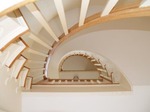 New semi-circular stair modelled on originalkeeper’s house may have originally been designed by noted Salem architect and wood carver Samuel McIntire. Now, it’s named The McIntire in his honor. It suffered a devastating fire in 1999 and regrettably had to be gutted. It houses three two-bedroom units ranging in size from 1718 sq. ft. to 1795 sq. ft. One contains a new gas fireplace. A surviving original fireplace mantel may be re-installed. Finegold Alexander + Associates Inc. designed the new front portico and front, semi-circular stair to emulate the originals.
New semi-circular stair modelled on originalkeeper’s house may have originally been designed by noted Salem architect and wood carver Samuel McIntire. Now, it’s named The McIntire in his honor. It suffered a devastating fire in 1999 and regrettably had to be gutted. It houses three two-bedroom units ranging in size from 1718 sq. ft. to 1795 sq. ft. One contains a new gas fireplace. A surviving original fireplace mantel may be re-installed. Finegold Alexander + Associates Inc. designed the new front portico and front, semi-circular stair to emulate the originals.
The 1,350 gross sq. ft. new building dubbed the Carriage House replaced a barn which was beyond repair in the same location. It is a free-standing two-bedroom unit with a gas fireplace.
Apartment rental rates at 50 St. Peter range from $1200 to $2600 per month.
The look
Each of the historic buildings pairs antique exteriors with updated interiors. “…Rather than do some knock off, the  Architect Jim Alexander in The McIntirefeeling was let’s contrast a bit with the wonderful exteriors, which we can restore, and realize contemporary living inside,” notes Alexander. In general, floors are new birch; custom kitchen cabinetry is full-overlay style in an espresso finish; kitchen appliances are stainless steel; countertops are quartz. Yet, in The McIntire, for example, doors are two-panel, baseboards are decent sized, and deep window jambs are splayed as they are in many 19th century homes. Alexander clarifies, “We like to think of it as more of a blended newer approach on the interior.”
Architect Jim Alexander in The McIntirefeeling was let’s contrast a bit with the wonderful exteriors, which we can restore, and realize contemporary living inside,” notes Alexander. In general, floors are new birch; custom kitchen cabinetry is full-overlay style in an espresso finish; kitchen appliances are stainless steel; countertops are quartz. Yet, in The McIntire, for example, doors are two-panel, baseboards are decent sized, and deep window jambs are splayed as they are in many 19th century homes. Alexander clarifies, “We like to think of it as more of a blended newer approach on the interior.”
 Typical Master Bath finishesDeveloper David Goldman was an active participant in selecting interior finishes. “I do micro-manage that part of a project,” laughs Goldman. “The idea was to make something very, very stylish, something that stands out in the marketplace, head and shoulders above the competition,” he says. The stone and recycled-glass tile selected for use throughout the project is an example. “That was a collaborative effort,” Goldman continues. “We really tried to use the aesthetics of the building, the tones of the building, and pick those up with a choice of tile that was consistent with the tone and aesthetic of the rest of the building.”
Typical Master Bath finishesDeveloper David Goldman was an active participant in selecting interior finishes. “I do micro-manage that part of a project,” laughs Goldman. “The idea was to make something very, very stylish, something that stands out in the marketplace, head and shoulders above the competition,” he says. The stone and recycled-glass tile selected for use throughout the project is an example. “That was a collaborative effort,” Goldman continues. “We really tried to use the aesthetics of the building, the tones of the building, and pick those up with a choice of tile that was consistent with the tone and aesthetic of the rest of the building.”
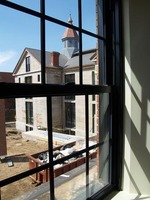 The Bryant from The McIntireIn The Bryant, granite and brick walls are often left exposed. “If you’re living there, it adds interest instead of the whole white wall of plaster -- you could get that anywhere,” says Alexander. Custom aluminum windows with baked, black enamel finish replaced original units. Some soar the approximate 14-feet height of those they supplanted. They’re modeled on the triple-hung sash style and muntin configuration of the originals. The two cupolas were left in place and are open to kitchens below on the attic level. At one point the team considered locating small studies in the cupolas, but reconsidered when the National Park Service required that the ventilating louvers remain in place. The roofing is Lamarite Slate Composite Shingles by Tamko which are lighter and more workable than real slate, which they closely resemble.
The Bryant from The McIntireIn The Bryant, granite and brick walls are often left exposed. “If you’re living there, it adds interest instead of the whole white wall of plaster -- you could get that anywhere,” says Alexander. Custom aluminum windows with baked, black enamel finish replaced original units. Some soar the approximate 14-feet height of those they supplanted. They’re modeled on the triple-hung sash style and muntin configuration of the originals. The two cupolas were left in place and are open to kitchens below on the attic level. At one point the team considered locating small studies in the cupolas, but reconsidered when the National Park Service required that the ventilating louvers remain in place. The roofing is Lamarite Slate Composite Shingles by Tamko which are lighter and more workable than real slate, which they closely resemble.
Conservation and sustainability 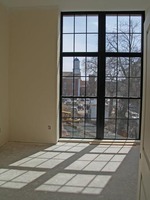 Windows in The BryantThough 50 St. Peter isn’t LEED (Leadership in Energy and Environmental Design) certified, Alexander believes it’s probably “LEED certifiable”. Adapting existing buildings for reuse is typically “greener” than starting from scratch. 50 St. Peter’s proximity to the train station, retail center, cultural amenities, and parks also makes it “greener” than more remote developments. Enhanced air-sealing and upgraded insulation can be expected to improve the buildings’ energy performance as will the new double-pane, Low-E, argon-filled, insulated glass windows. Appliances are Energy-Star rated, and high-efficiency, gas-fired heating and cooling systems are used throughout. Some existing granite floor slabs are being recycled as landscape paving.
Windows in The BryantThough 50 St. Peter isn’t LEED (Leadership in Energy and Environmental Design) certified, Alexander believes it’s probably “LEED certifiable”. Adapting existing buildings for reuse is typically “greener” than starting from scratch. 50 St. Peter’s proximity to the train station, retail center, cultural amenities, and parks also makes it “greener” than more remote developments. Enhanced air-sealing and upgraded insulation can be expected to improve the buildings’ energy performance as will the new double-pane, Low-E, argon-filled, insulated glass windows. Appliances are Energy-Star rated, and high-efficiency, gas-fired heating and cooling systems are used throughout. Some existing granite floor slabs are being recycled as landscape paving.
Jailhouse home
As of this writing, Merry Fox Realty reports at least 30% of the complex is rented. Susan Moulton, who’s selling the home she’s owned in Winchester for 26 years, jumped at the chance to sign up for a 2-bedroom apartment in the brick annex of the Bryant. “I had the pleasure of doing a little work in Salem a couple of years ago and was enchanted by the city. I’m looking for something different from suburban living, and this is both a gorgeous place and a fabulous location in terms of walkability,” she says. The jail’s past doesn’t daunt her. “I don’t believe in ghosts or bad spirits,” she asserts.
Neither does architect Jim Alexander. He remarks, “Jails have amazing histories in towns. People don’t realize it, but they were highly prized as a source of industry, a source of business. It was an employment center. Sure, there were prisoners, but there were guards; there was a jailor; there was food service.”
Now, thanks to Alexander and the rest of the 50 St. Peter team, the adapted Old Salem Jail can be prized as a source of new community, contributing life and business to the city it inhabits. Alexander concludes, “This is fun. I would live here.”
See the "before" first-floor plan of the Old Salem Jail and the "after" of The Bryant. See the "before" first-floor plan of the jail-keeper's house and the "after" plan of The McIntire. See the first-floor plan of the Carriage House.
by Katie Hutchison for House Enthusiast and North Shore Art Throb

